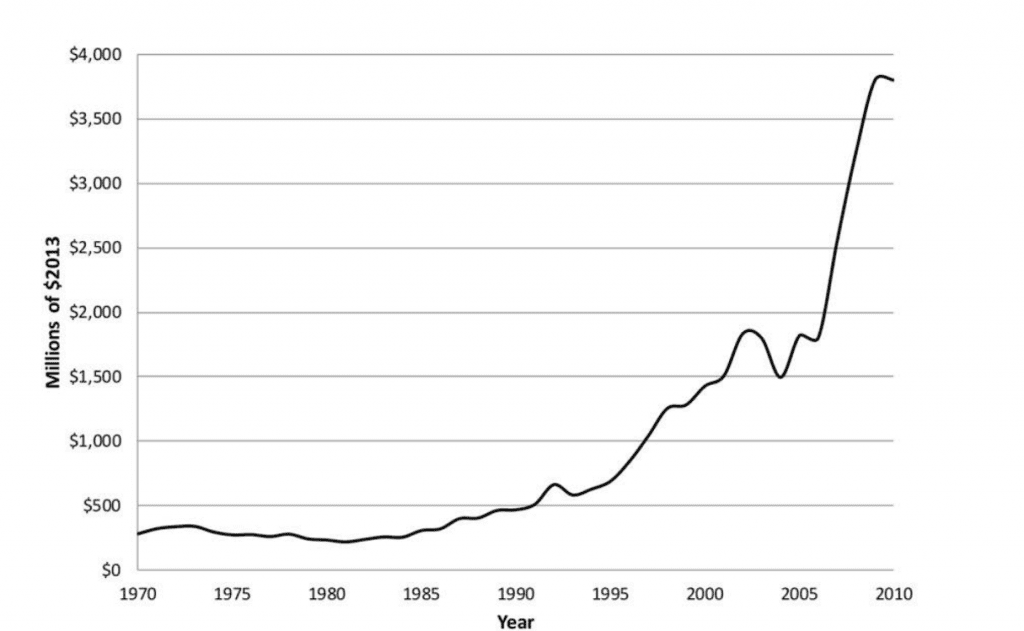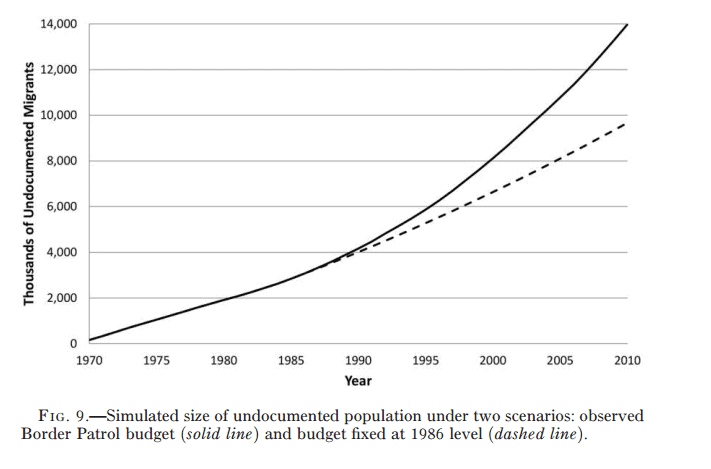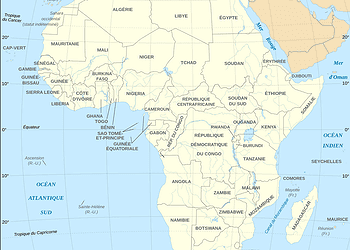“I will make a GREAT, GREAT wall and make Mexico pay for it,” Donald Trump famously said. This statement is medieval in both approach and mindset, but the rhetoric has worked fantastically for Trump. Why are we acting so surprised, though? Trump is only the most recent in a long line of politicians who have turned to demonizing immigrants to advance their own political agenda — all in the disfavor of the American taxpayer.

Historically, many Mexican laborers would arrive in the United States legally with six-months Bracero Program visas to work seasonal jobs before returning to Mexico. In 1964 the Bracero Program ended, but the laborers would still keep flowing in undocumented. Their seasonal migration pattern did not change, though. Then in 1986, the U.S. Congress passed the Immigration Reform and Control Act (IRCA), which cracked down on undocumented hiring and increased the number of border patrol officers.
“For every million-dollar increase in budget, the odds a migrant would return home to Mexico in any given year dropped by 89 percent.”
This policy has been disastrous. In the two decades preceding the controversial bill, as many as 85 percent of undocumented arrivals were offset by departures. Post-IRCA, most immigrants became trapped, causing the U.S. undocumented immigrant population to soar to 12 million in 2008.
An analysis made by Princeton University researchers last year suggests for every million-dollar increase in budget, the odds a migrant would return home to Mexico in any given year dropped by 89 percent. In other words, the more money the government is spending, the more so-called ‘illegal immigrants’ arrive and stay in the United States.

Now, the same team of researchers has gone in greater depth exploring the failed border enforcement policy of the last three decades.
“The principal substantive finding of our analysis is that border enforcement was not an efficacious strategy for controlling Mexican immigration to the United States, to say the least. Indeed, it backfired by cutting off a long-standing tradition of migratory circulation and promoting the largescale settlement of undocumented migrants who otherwise would have continued moving back and forth across the border. This outcome occurred because the strategy of border enforcement was not grounded in any realistic appraisal of undocumented migration itself but in the social construction of a border crisis for purposes of resource acquisition and political mobilization. Although these arguments have been made previously, never before have instrumental variable methods been applied to such a wide range of border outcomes and migrant behaviors to assess the causal effect of U.S. border enforcement,” the researchers write in the paper published in the American Journal of Social Psychology.
Douglas Massey and Karen Pren at Princeton University measured the efficacy of border enforcement using data like the DEA budget or records from the Mexican Migration Project. Using regression statistical techniques, the authors could predict border crossing outcomes like the cost of crossing, the likelihood of getting arrested, and the use of smuggling known as “coyote”.
The analysis suggests that a seemingly tight and enforced border did more harm than good by essentially trapping seasonal migrants. Today, most undocumented Mexicans have settled permanently nationwide, but only 30 years ago most undocumented migrants were confined to only three states.

This is a seemingly paradoxical situation, but once carefully lensed becomes quite clear. As the border becomes more and more outrageously militarized, the associated cost of crossing jumps as well. Migrants will go to greater lengths to cross the border for a job, and to offset costs they will have to stay longer. Since getting in is a lot easier than getting out, this risk keeps many undocumented Mexican migrants trapped, and the longer they stay the likelier it is they will settle. Migrants will also settle across the nation in search for jobs and to reduce the risk of apprehension — the more north the better.
Simulations back the findings showing that had the border control been akin to that of 1986, the undocumented migrant population would have been smaller.
In a situation that mirrors the war on drugs or the war on terror, the war on migrants has totally backfired. It wastes money, promotes crime and puts countless lives at risk who have to make a most perilous journey. From a rather common occurrence, now most undocumented migrants are smuggled by “coyotes” or “polleros”. Illegal immigrants face kidnapping, murder, and rape at the hands of violent drug cartels and ever more ruthless human smugglers. Crossing treacherous desert areas exposes the travelers to heat exhaustion and dehydration. Hundreds of people die every year trying to cross the border into the U.S.
“The combination of increasingly costly and risky trips and the near certainty of getting into the United States created a decision-making context in which it still made economic sense to migrate but not to return home to face the high costs and risks of subsequent entry attempts. In response to the changed incentives, the probability of returning from a first trip fell sharply after the 1980s, going from a high of .48 in 1980 to zero in 2010, although with significant year-to-year variation connected to fluctuating social and economic conditions in Mexico and the United States,” the researchers conclude.
The findings suggest that border militarization has failed and any steps to militarize it even further are bound to make matters worse. In this context, Trump’s “great wall” is maybe the quintessence of asinine border and migration politics. Instead, reducing border enforcement and streamlining legal migration will vastly increase the odds of return migration, offsetting undocumented migrant population growth. That’s for practical reasons. Then, there’s the moral responsibility to treat fellow human beings kindly and respect neighboring countries.





